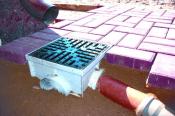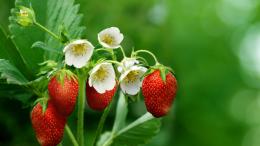Search
Login
Strawberries: planting, growing, fertilizing and care
Even if there is little space in the garden, it is likely that you can still allocate a small area for the fragrant berry. Strawberry seedlings can grow not only horizontally, but also on vertical supports, and a flowering plant, completely replaces any decorative. Agree, strawberries have a number of advantages - fragrant, sweet and healthy, there would be a sunny area, but we will tell you how to grow it.
Content:
- Choose a plot
- Seedlings and seeds video
- Choose a variety
- Landing
- Strawberry Care and Feeding video
- Strawberry disease
Choose a plot
The strawberry plot must be sunny or in partial shade, but so that the sun falls on the strawberries in the morning or evening. The soil is selected light, not marshy, preferably slightly acidic (pH from 5.5 to 6.5). Do not plant strawberries next to tomatoes, potatoes, raspberries, cucumbers and cabbage.
If there is no place for planting the soil in the garden, the ability of the strawberries to grow in length will help. Strawberry on vertical supports, weaves and gives a crop no worse than on a horizontal surface.
Seedlings and seeds
Strawberry cultivation should begin with the acquisition of healthy seedlings. The market offers two types of seedlings - seedlings in pots and seedlings Frigo. Consider the difference between these two types.
Strawberry seedlings in pots with peat substrate are available for sale from mid-August, the crop, respectively, will appear only next year.
Frigo strawberry seedlings are more preferable among Europeans, since there is an opportunity to get a crop in the year of planting. Nursery owners dig up seedlings in late autumn, remove leaves, sort and pack. Plants are stored until spring in refrigerators at a temperature of 1.5 C.
Frigo seedlings are planted in early May, 30 days after planting, strawberries bloom, 30-40 days after flowering, the first berries appear.
Another way to grow strawberries is seeds. In fact, this is a very complex process, in addition, all known strawberry varieties are propagated only by cuttings or seedlings. However, nothing prevents the experiment and grow seedlings with seeds. Among gardeners, there is an opinion that strawberries do not yield crops in the first year of planting, but this is not so, it all depends on the nutritional value of the soil and the lightness of the site. If you plant strawberry seeds in March, then in May plant the seedlings in the ground, it is possible that in June the plant will bloom and give fragrant berries.
Choose a variety
Depending on the variety of strawberries, the crop is received around the end of May. The amount of harvest depends on the age of the shrub and care. In private households, strawberries are recommended to be grown in one place for no more than five years. Strawberry varieties differ in the size and shape of the berries, ripening, juiciness, taste and aroma, resistance of the shrub to frost and disease.
It's hard to talk about the popularity of varieties, each gardener has his own set of varieties, always the best. There are a lot of varieties of strawberries, consider several varieties.
Early varieties of strawberries - Kama, Octave, Maryshka. Varieties of medium maturity - Carmen, Queen, Stranger.
Later varieties of strawberries - Bourbon, Pegasus, Maestro.
Landing
The plant is planted in spring, summer or autumn. Strawberries are planted in rows, beds for strawberries are made at a distance of at least 50-60 cm, the distance between the bushes is 30 cm, from these indicators we calculate how many seedlings you will need per square meter of the allotted area.
Before planting, it is recommended to lower the strawberry roots into a solution with minerals (nitrogen, phosphorus, potassium) for 2-3 hours. Wells for seedlings should be deep and wide so that the roots of the plant do not crumple. It is best to plant strawberries in cloudy weather or in the evening when there is no scorching sun.
Strawberry Care and Feeding
Strawberries are not resistant to drought and require watering as the soil dries, you should know that strawberries with a lack of moisture yield small and not juicy berries, and the bush is susceptible to disease.
To get a rich harvest for five years, regularly remove shoots (tendrils), otherwise the plant will spend its energy on new shoots.
Immediately after picking berries on old shrubs (2-3 years), the leaves are cut, so that the shrub rejuvenates and hardens. Controls moisture loss and facilitates weed control by mulching with straw; in addition, the straw will keep the berries clean.
Strawberries respond well to fertilizers, the main minerals for strawberries are nitrogen, phosphorus and potassium, and strawberries need less calcium and magnesium. Nitrogen is responsible for the growth of green mass, phosphorus affects the development of the root system, potassium enhances flowering and fruiting. Strawberry dressing is used in early spring and after flowering.
In winter, to protect against severe frosts, it is recommended to cover strawberries with straw 5-8 cm thick.
Strawberry disease
Growing strawberries in the garden can be seriously complicated by its diseases, if measures are not taken in time, as you know, troubles are easier to prevent than to solve them later. To date, there are a number of fungal and viral diseases. Briefly on the fight against the most famous fungal diseases, below.
Gray rot - It occurs mainly on flowers and berries, the infected parts quickly darken and dry out. These are soft putrefactive spots covered with gray mold. Treatment does not give visible results, only prevention is possible, namely, a sufficient distance between plants, limitation of nitrogen fertilizers, removal of infected berries and leaves.
Also, to strengthen the protective properties, before flowering, strawberries are watered with slurry or a decoction of onion husks. After harvest, the infected shrubs are completely cut, the cut leaves are burned.
Powdery mildew, another disease caused by a fungus. The underside of the leaves and buds are covered with white coating, the infected parts of the plant gradually die, and the coated fruits are not suitable for food. To prevent powdery mildew, strawberries are treated with sulfur during flowering and after harvest.
Red root rot Usually manifests itself on moist, heavy soil, where the sun's rays rarely fall and at a relatively low temperature (10 - 15 C, that is, in spring or autumn). Infected roots stop the development of shrubs. At the first symptoms of the disease (plants do not grow, leaves turn yellow and dry), it is worth examining the roots of one of the bushes - the infected parts of the root system are darker than healthy ones.
Unfortunately, this disease is difficult to eliminate, as the soil is contaminated. The disease will be prevented only by soaking strawberries before planting adapted fungicides in a solution.
Viral diseases have quite similar manifestations - yellow leaves, spots on the leaves, reduced yield. Accurately determine the type of virus can only be done using a bioassay. The carriers of the virus can be insects - aphid, ticks, nematodes. In this case, first you need to get rid of harmful insects. After picking berries, the leaves are cut and destroyed.
The best way to avoid problems is by choosing disease-resistant varieties, buying seedlings from certified sellers, and following the rules when planting.





